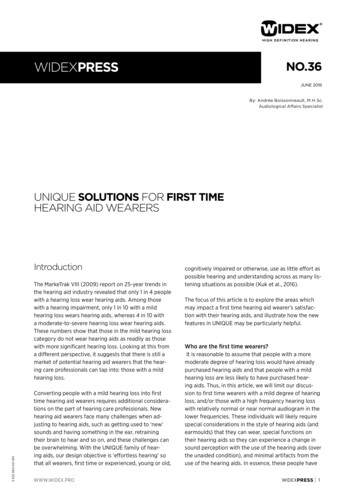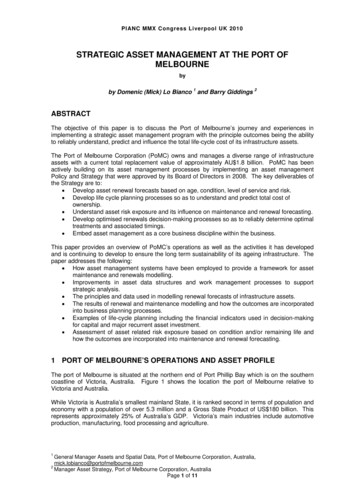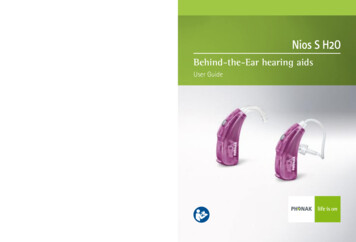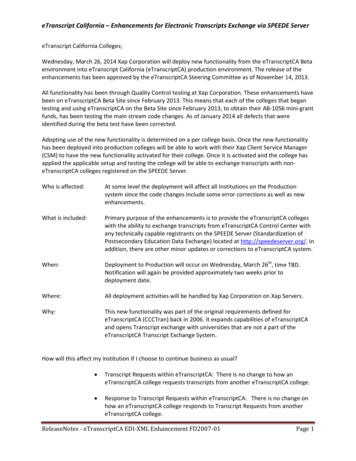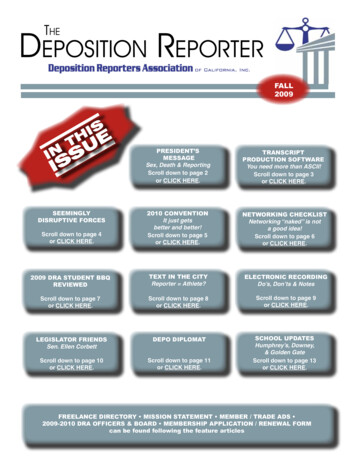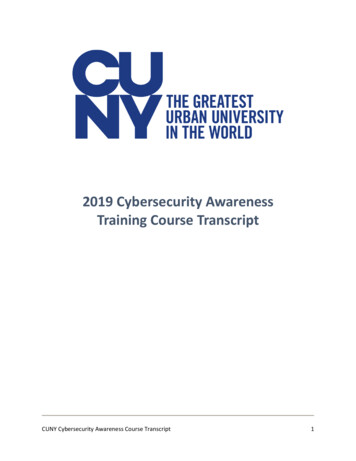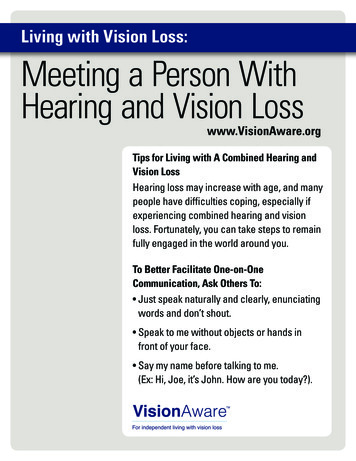
Transcription
PUBLIC HEARING ONRESPONSIBLE LENDING GUIDANCEAustralian Securities & Investments CommissionTRANSCRIPT OF PUBLIC HEARINGMELBOURNEMonday, 19 August, 2019, at 9.15amAt Balmoral Room, Stamford Plaza Hotel,111 Little Collins Street, MelbourneBefore:Mr Sean Hughes, CommissionerMs Karen Chester, Deputy ChairMs Danielle Press, Commissioner
TABLE OF CONTENTSINTRODUCTION. 1CONSUMER ACTION LAW CENTRE . 9 Mr Gerard Brody, CEO Ms Amanda Storey, Director of Legal Practice Ms Brigette Rose, Senior Policy OfficerCONSUMER CREDIT LEGAL SERVICE WA . 27 Ms Gemma Mitchell, Managing Solicitor Ms Roberta Grealish, Senior SolicitorLIXI LIMITED . 45 Mr Shane Rigby, CEO Mr Mike Thanos, DirectorMELBOURNE INSTITUTE. 57 Prof. Guyonne Kalb, Professorial FellowMORTGAGE CHOICE . 70 Ms Susan Mitchell, CEO Mr Tim Donahoo, Head of Lending OperationsCONNECTIVE . 93 Mr Mark Haron, Executive Director Mr Daniel Oh, Group Legal CounselAUSTRALIAN FINANCE GROUP. 116 Mr Mark Hewitt, General Manager for Industry and Partnership Development Mr Tony Bird, Head of Risk and ComplianceAUSTRALIAN FINANCIAL COMPLAINTS AUTHORITY . 135 Mr David Locke, CEO and Chief Ombudsman Ms Evelyn Halls, Lead Ombudsman for Banking and Finance Mr Geoff Browne, Lead Ombudsman Mr Geoff Bant, Banking Ombudsman at AFCAAUSCRED (LENDI) . 162 Mr David Hyman, Managing Director Mr Martin Lam, Technology and OperationsNATIONAL AUSTRALIA BANK . 183 Mr Paul Riley, General Manager of Home Lending Mr Anthony Waldron, Executive General Manager of Broker PartnershipsANZ . 215 Ms Kate Gibson, Managing Director for Consumer Banking Mr Martin Joy, Senior Manager for Public Policy
MELBOURNE PUBLIC HEARING12INTRODUCTIONMR HUGHES:Good morning and welcome to the public hearings for3consultation on ASIC’s guidance on the responsible lending4obligations. My name is Commissioner Sean Hughes and I’m joined5by my fellow Commissioner, Deputy Chair Karen Chester, and6Commissioner Danielle Press will be joining us as well today.7I want to begin by acknowledging the traditional custodians of the8land on which we meet today and pay my respects to their Elders past9and present. I extend that respect to Aboriginal and Torres Strait10Islander peoples here today emerging as leaders as well.11These hearings are held under section 277 of the National12Consumer Credit Protection Act 2009 and I will be presiding at this13hearing. Before we commence with our first participants I’ll provide a14brief background on responsible lending, our reasons for conducting the15public hearings, how these hearings will proceed, the matters we aim to16address today and finally some housekeeping matters. However, it17would be remiss of me not to say something about our recent18responsible lending litigation against Westpac and I’ll propose to start19there.20As you all know the Federal Court handed down its decision on21Tuesday, last week and dismissed ASIC’s application. This was a test22case for ASIC and it’s important that we bring such cases. We took on23the case because of the need for judicial clarification of a cornerstone24legal obligation on lenders. As a regulator it’s our role to test the law19/08/20191Transcript has not been verified for accuracyIntroduction
MELBOURNE PUBLIC HEARING1and its ambit. The case focused on the conduct of the unsuitability2assessment. The obligation to assess whether a loan is unsuitable for a3particular consumer builds on the requirement for licensees to make4inquiries about a potential borrower’s financial situation and to verify5the information that is obtained. As you will all have read, we are6carefully considering the decision and its impact more generally on7responsible lending and that’s all we will be saying about this case8today.9The responsible lending obligations are principles based. Lenders10and brokers are required to make both reasonable inquiries into a11borrower’s financial situation and to take reasonable steps to verify12relevant information. Parliament introduced the responsible lending13laws to ensure that anyone applying for a loan was not provided with14one that they could not reasonably afford.15obligations is on each individual applicant for credit meaning that the16test of what is reasonable is one that looks to the individual consumer’s17circumstances.The focus of these18The responsible lending obligations commenced nearly 10 years19ago. At that time ASIC published guidance to assist industry to better20understand their obligations and ASIC’s expectations for compliance.21This guidance has not been updated since 2014. We at ASIC have taken22numerous responsible lending actions and these actions have tested and23provided clarity on the law. We’ve also ensured that consumers harmed24by irresponsible lending are compensated and real consequences for19/08/20192Transcript has not been verified for accuracyIntroduction
MELBOURNE PUBLIC HEARING1those who engage in misconduct is enforced. It’s important to be clear2about when responsible lending obligations apply and equally when3they do not. The responsible lending obligations apply to credit that is4wholly or predominantly for personal, domestic or household purposes.5This extends from small amount credit contracts and consumer leases6to personal loans and credit cards to home loans and loans for investing7in residential property.8Responsible lending obligations do not extend to loans that are9predominantly for other investment or business purposes even if10secured over residential property and these loans are not the subject of11our hearings or this consultation. The consultation paper we issued in12February, and which I’ll come to shortly, noted that it might be useful13for our regulatory guidance to be very clear about what is and what is14not covered and that is also important in the context of the process such15as today’s.16Our Regulatory Guide 209, or RG 209, has been in place since172010. This guidance sets out ASIC’s expectations for meeting the18responsible lending obligations.19guidance rather than setting minimum standards.20provides guidance on factors to consider when making a decision about21the level of inquiries or verification steps that are reasonable. Since its22introduction, ASIC has updated RG 209 to reflect judicial commentary23and new legislative requirements for certain kinds of credit. RG 20924was last updated in November 2014. We’re taking this opportunity to19/08/2019It was developed as indicative3Transcript has not been verified for accuracyFor example, itIntroduction
MELBOURNE PUBLIC HEARING1update our guidance to ensure it remains relevant, clear and timely.2New data sources such as open banking and comprehensive credit3reporting, learnings from ASIC’s reviews in recent years and4importantly judicial consideration of responsible lending laws all mean5this update is timely.6In February this year we issued Consultation Paper 309, CP 309,7Credit Licensing: Responsible Lending Conduct. We’ve received 728submissions in response to this paper of which 64 non-confidential9submissions were published on our website in July. We’ve reviewed10each of these submissions and the participants have been invited to11these hearings have been drawn from those who provided a written non-12confidential submission. Our selection of participants has focused on13delving deeper into particular issues which we feel would benefit from14further consideration, and we consider that the participants that we have15selected are best placed to assist us with our inquiries. Now, not all16parties who made a submission have been invited to appear at these17hearings. Each submission has been carefully considered and following18these hearings we will consider further opportunities to consult19including with parties who have not been invited to participate in these20hearings.21Ladies and gentlemen, the purpose of these hearings is to provide22an opportunity to explore and to seek to better understand key themes,23concepts and practices including significant matters raised by24stakeholders and submissions. Participants have been informed of the19/08/20194Transcript has not been verified for accuracyIntroduction
MELBOURNE PUBLIC HEARING1broad matters that ASIC is interested to hear from them about. This is2importantly an information gathering exercise. It is not an investigative3or enforcement exercise.4adversarial manner the business operations of the entities that are5represented here today. Instead we would like to test the views raised6by stakeholders in their submissions.We are not here to interrogate in an7ASIC will not be providing guidance to entities through these8hearings and I want to emphasise that nothing that is said today should9be taken as a final ASIC position. Licensees can have confidence in10relying on existing guidance and expectations. These hearings, the11submissions made and any further consultation we undertake is12invaluable to increasing ASIC’s understanding of the current consumer13lending landscape and the regulatory issues faced.14At the conclusion of ASIC’s full consultation process, we will15publish a report that outlines submissions received in response to16ASIC’s consultation paper including additional information provided17throughout these hearings and our response. We will also publish the18updated regulatory guidance setting out our views and expectations for19licensees. This will provide further clarity on ASIC’s position on how20responsible lending obligations should be implemented with the benefit21of having considered the views of stakeholders who have participated22in this consultation. And we expect to publish our updated guidance by23the end of this calendar year. Now, as for today’s hearings the matters24which we aim to address through today include: firstly, the approach19/08/20195Transcript has not been verified for accuracyIntroduction
MELBOURNE PUBLIC HEARING1to post-loan spending reductions, how this relates to substantial2hardship and its relevance for the consumer’s objectives in relation to3credit; second, whether there should be a difference for the relevant4importance between considering indebtedness as compared with the5circumstances of the customer; third, the role of brokers and the6importance of the responsible lending obligations to that role; and7finally credit access. Are lower standards a reasonable starting point8for credit cards and personal loans other than SACCs and home loan9refinance in some circumstances?10Now, ladies and gentlemen, while we will conduct this hearing11with as little formality and technicality as possible, I need to remind you12that the audio of these proceedings is being taken and live streamed. A13full transcript will be available on ASIC’s website. Media14representatives may take photographs and audio visual recordings of15my introductory remarks but not those of the participants. Media may16only use audio recording devices during the hearing for note taking17purposes. Participants have each been provided with a time slot and we18will endeavour to stay within the time allotted. Participants will be19invited to introduce themselves, their organisation and their roles and20have the option to provide very brief opening remarks, no longer than21two minutes. I want to remind participants that we have read their22submissions. Opening remarks should not repeat matters contained in23those submissions except to highlight one or two key matters that they24wish to bring to our attention.19/08/20196Transcript has not been verified for accuracyIntroduction
MELBOURNE PUBLIC HEARING1Written opening statements or other documents which2participants wish to provide or refer to will be treated as an addendum3to their submission and will be published on our website. Participants4are required to be truthful in their remarks. A person who appears at5this hearing must not give information that is false or misleading. I also6want to remind everybody here today that we will not be taking7comments from the floor. For the smooth running of these hearings and8to avoid disruptions, we ask all those in attendance to keep noise to a9minimum. And for those who are not called as participants who wish10to provide further information or feedback to ASIC or on our proposed11guidance about these hearings, we ask that you please speak to the ASIC12staff at the registration desk.13And one final comment on the submissions more generally. I14indicated earlier that we have received 72 submissions. There are15indeed some matters raised in the submissions that we factually,16fundamentally or otherwise disagree with, but we do not intend to17address or respond to all of these matters in these hearings. We may18refer to some of these matters as relevant and important to today’s19discussion, but I want to emphasise that our silence on a matter raised20must not be inferred as acceptance of it. Similarly, statements may be21made throughout the course of today that are contrary to our22understanding or indeed our view. Our purpose through these hearings23is to listen and not to make decisions. Our position on these matter,24where relevant, will be published in the report that outlines our response19/08/20197Transcript has not been verified for accuracyIntroduction
MELBOURNE PUBLIC HEARING1to submissions made through the consultation process and our updated2guidance.3Now, finally some quick housekeeping matters. We ask that4everybody in attendance please switch off or put on silent any mobile5phones or other devices. In the event of an emergency requiring the6evacuation of this building, please follow the instructions of the7wardens and head towards the green exit signs at the back of this room.8Your emergency assembly point is on the corner of Little Collins Street9and Exhibition Street. And if you believe that you need assistance10evacuating, it’s important that you advise the wardens, who will be able11to assist you. If otherwise you require assistance, please speak to one12of our staff members at the registration desk outside the hearing room.13Without any further introductory remarks, I would now like to14welcome the representatives from Consumer Action Legal Centre to15introduce themselves and to commence this hearing. Thank you.19/08/20198Transcript has not been verified for accuracyIntroduction
MELBOURNE PUBLIC HEARING1CONSUMER ACTION LAW CENTRE2MR BRODY: Good morning. My name is Gerard Brody, the CEO at Consumer3Action Law Centre, and with me is Amanda Storey, our Director of4Legal Practice, and Brigette Rose, our Senior Policy Officer. Consumer5Action is an independent not-for-profit consumer organisation with6direct experience of people’s experiences through our phone advice7lines and casework. Our financial counsellors run the National Debt8Helpline in Victoria and our lawyers provide legal advice through our9legal helpline and in representing clients.10Our primary point today is that the regulatory guidance should be11based on what the law actually says and help clarify aspects of what is12meant to lend responsibly. While the law is principles-based, it appears13to us that the recommendations offered by lenders, including most of14the major banks, reiterate that a principled approach to responsible15lending is not working. More clarity and detail is required.16However, as noted by Commissioner Hayne in his interim report17in the royal commission, responsible lending isn’t about loan18serviceability and a lender’s credit risk appetite. These assume a19proportion of borrowers will default. It’s about compliance with the20legal requirements to ensure a credit contract is not unsuitable for the21individual consumer, that it is affordable for the consumer without22putting them into substantial hardship and it meets their requirements23and objectives.19/08/20199Consumer Action Law CentreTranscript has not been verified for accuracy
MELBOURNE PUBLIC HEARING1That’s our primary concern with the decision of the Federal Court2last week, that it seems to suggest that the law doesn’t require lenders3to look at the position of the individual applicant in front of them. To4look at that applicant’s requirements and objectives and whether the5repayments will cause hardship for that particular applicant. We look6forward to answering your questions.7MR HUGHES: Thank you, Gerard. And welcome to you and your colleagues.8At the Sydney hearing on Monday last week, we heard from a number9of lenders that the question of the customer’s financial situation should10be focused more on income and indebtedness than on expenses, which11can be subject to change. Can you give us your views on the balance12of those two issues?13MR BRODY: Our position is that to understand someone’s financial position,14you necessarily have to look at what income indebtedness as well as15living expenses. And to understand, you know, whether it is possible16in that particular consumer circumstances that there is room to cut down17on expenses. That may be a possibility for some applicants but it may18not be for other applicants. And to understand that, you need to look at19their expenses, you need to have a conversation with them about their20financial position. Amanda has a bit of case study that I might ask her21to [indistinct]22MS STOREY: Yes. I wanted to touch on one of the witnesses, that is also our23client, Robert Regan, who gave evidence about ANZ’s home loan. And24he was given a 50,000 home loan that was secured against his19/08/201910Consumer Action Law CentreTranscript has not been verified for accuracy
MELBOURNE PUBLIC HEARING1previously unencumbered home. The royal commission found that his2expenses were underestimated by half. But, critically, he also had very3significant withdrawals leading up to the loan, which were evidenced4in the bank statements. And the commission found that they assessed5the income by verifying the statements but looked at none of the very,6very large withdrawals. And, so, if the focus were to shift as the lenders7propose, to just income indebtedness, this situation would definitely8arise again. And the evidence from Robert was that he went quite9quickly into quite severe financial hardship, he relied on charities for10food. And that’s just not acceptable.11MR HUGHES: Thank you.12MS CHESTER: So on the issue of expenses then, we hear from some lenders –13not all the lenders, but some lenders – that using bank statements is14quite manual, it’s intrusive, and not highly automated, and a suggestion15that valuable insights can’t be really gleaned from them. It would be16good to get a sense of what other risk factors you’d identified based on17consumer experiences and the case studies that you got that you think18could be gleaned from some review of, perhaps not forensic, but some19review of bank statements.20MR BRODY: Yes, there is a range of things that can be gleaned by looking at21bank statements that, I firstly would say that it’s important to look at22overall expenses and just do a simple mathematical calculation of23income and outgoings to determine to see if there’s any really an24amount to be able to service the loan.19/08/201911Consumer Action Law CentreTranscript has not been verified for accuracy
MELBOURNE PUBLIC HEARING1But beyond that, I think the bank statements also provide a range2of potential indicators of issues that affect that consumer’s financial3situation and whether repayments will cause substantial hardship. So,4for example, if the bank statements disclose that there is regular5over-drawing of an account, that might be an indicator. If there are6regular gambling transactions, that itself might be an indicator. Or in7the case, for example, that Amanda talked about, unexplained, large8withdrawals, that also might be an indicator, that would invite a lender9to take further inquiries and steps to verify and understand that10applicant’s financial position in more detail.11MS STOREY: I would also add, if there are debits that are coming out from,12say, debt collection agencies, that would suggest that that borrower has13been in a position of arrears potentially recently and also with the point14of with SACCs in particular, you do actually need to look at whether or15not there have been withdrawals from other payday lenders in order to16comply with the law as well.17MS CHESTER: So, I guess from what you’re saying, a little bit more of a18risk-based assessment through the lens of the consumer, similarly19we’ve had feedback in some submissions and indeed we heard in the20hearings in Sydney last week, the concept of inquiry and verification21being scalable based on a risk-based assessment. And an example there22was scaling up the assessment for the size of the credit, so greater23inquiry and verification around, say, a mortgage versus that of a 10,000,24 20,000 credit card.19/08/201912Consumer Action Law CentreTranscript has not been verified for accuracy
MELBOURNE PUBLIC HEARING1It would be good to get your assessment based on the experience2that you had through the debt hotline and helpline and other case studies3that come your way with legal advice in terms of what are the most4problematic forms of credit, looking at it again through the lens of the5consumer. And if we’re taking a risk-based assessment, how would you6view different forms of credit and requirements under responsible7lending obligations?8MR BRODY: Well, the first thing to say is we wouldn’t agree that the size of9the loan is the sole indicator about whether more inquiries and10verification steps should be taken and we support the existing guidance11and directory guide and in fact small amounts of loan, like small amount12loans can actually be more impactful for a consumer’s financial13position, including causing substantial hardship.14We did conduct a bit of analysis of our calls to the National Debt15Hotline over a two year period, leading up to June, 2019, and in fact16unsecured credit is the primary reason people call. So, out of 18,73017files where financial difficulty was recorded in the call notes, 37 per18cent of those had related to a credit card debt, 20 per cent with a personal19loan and 12 per cent with both.20Credit cards themselves can be, you know, a real problem with21people because of the very design of that product in the fact that the22minimum repayments can be set at a very low level and people can be23paying, you know, complying with the terms of the product but paying24large amounts of interest over time, causing them financial difficulty.19/08/201913Consumer Action Law CentreTranscript has not been verified for accuracy
MELBOURNE PUBLIC HEARING1So we don’t think that, yeah, that the small amount or the type of the2credit is necessarily the main concern to consider whether there should3be a lesser inquiry for a particular product. I mean, we have released a4report, last week in fact, with some colleagues looking at the way in5which some small loans become a huge problem for customers. For6example, in the context of where they go into arrears and a judgment’s7obtained and then bankruptcy action is taken. We see, we’ve seen time8and time again of people who has had a small amount of, a small credit9card of 5,000 rack up to, you know, a debt of 60,000 once legal costs10and trustee fees arise. So I would not say that, you know, a small11amount of credit is the main reason to be not taking those inquiries.12MS STOREY: And to take that further, that is actually, ultimately leads to sale13and seizure of their home and the borrower becoming homeless and also14their family members as well, and the flow-on effects of if they’ve got15children, for them not be able to go to that school anymore. So the idea16that it’s just a small loan, it’s contained, it’s not what we see with our17telephone advice lines.18MS CHESTER: So in that sense, for a lot of those sorts of smaller unsecured19credit loans, there is a high usage, we’re seeing in the statistics around20the process for assessment being fully automated. How do you see that21in terms of balancing the risk for the prospective consumer and what22could and could not be missed with respect to responsible lending23obligations?19/08/201914Consumer Action Law CentreTranscript has not been verified for accuracy
MELBOURNE PUBLIC HEARING1MR BRODY: Well, I think that, that automated credit decision making models2can be really problematic. I think that they possibly can be built in a3way that is better than others and I guess we’ve seen some really poor4examples where assumptions are made about a person’s ability to, you5know, expenses. So relying on a benchmark rather than people’s actual6position which then doesn’t allow for that inquiry to see if those risk7factors that we talked about before. So I think necessarily an automated8process is, is insufficient to, to meet the requirements of the responsible9lending laws.10MS STOREY: And some of our case studies in our submissions talked about11the circumstance of family violence in particular and so there you’ve12got a particular dynamic where if you have more of a human13intervention and looking at, well, who’s getting this loan, who’s the true14beneficiary of this loan and does this loan meet both the borrower’s15objectives and if it’s fully automated that won’t be detected.16MR BRODY: The other thing to say about automated processes is that, you17know, the law actually talks about inquiries and verifications about18financial position but it’s also a requirement to inquire about borrower’s19requirements and objectives and automated processes or processes20which rely on tick a box approach to what a consumer’s requirement21objectives are, we think that insufficient and actually do not comply22with the law.23requirements and objectives, rather than seeking to understand it.19/08/2019That’s more about determining the borrower’s15Consumer Action Law CentreTranscript has not been verified for accuracy
MELBOURNE PUBLIC HEARING1MR HUGHES: That leads then into the next question around what value you2see the broker relationship providing, particularly in terms of the3preliminary assessment that they undertake. So you can talk to us about4your experience from your client’s perspective of using brokers?5MR BRODY: In terms of the clients that we assist that use brokers, our6assessment would be that brokers are more often than not used to help7people obtain unaffordable credit. People that have difficulty getting8loans may turn to a broker and get access to credit that may cause them9substantial hardship and that’s common in our casework.10MS STOREY: The legal team in particular looks at when it all goes wrong. So,11and when brokers have been involved in those cases in particular, there12is an element of fraud involved or family violence where the, the13brokerage interaction helped perpetrate further family violence.14MR BRODY: And I think when it comes to brokers, we can’t remove the15misaligned incentive that exists in that channel, where brokers get a16commission for placing the loan, they don’t get any payment if the17consumer is ineligible for a loan or they might get a smaller loan then18they'll get a reduced return. So that, it’s provides the incentive for19brokers to prefer their interest over their duty when it comes to20responsible lending. But we would say, and we agree with the royal21commissioner again, that these, you know, there is independent duty for22brokers compared to lenders when it comes to responsible lending.23They are meant to do their own steps as part of inquiry and verification24about financial position. And importantly, brokers are perhaps better19/08/201916Consumer Action Law CentreTranscript has not been verified for accuracy
MELBOURNE PUBLIC HEARING1placed than lenders to do the inquiry about requirements and objectives2because they’re more likely to meet with the customer and so they3should be, you know, having those discussions and understanding what4the borrower’s purpose is when, when taking out a loan.5MR HUGHES:So I think you’re describing what the royal commission6recommended and what the Treasurer has announced today as a best-7interests model. Do you then suggest that the role of the broker should8be to perform a gatekeeper assessment role?9MR BRODY: Yes. I mean, absolutely. The, the brokers do need to, as I said,10because they are likely to be meeting with the client and more likely to11understand their position, I think that the lender ultimately, they have12their duties as well and that perhaps they’re more incentivised than the13broker to ensure that repayments are payable because it’s their loan at14the end of the day. But
reporting, learnings from ASIC's reviews in recent years and . 4. importantly judicial consideration of responsible lending laws al l mean . 5. this update is timely. 6. In February this year we issued Consultation Paper 309, CP 309, 7. Credit Licensing: Responsible Lending Conduct. We've received 72 . 8
